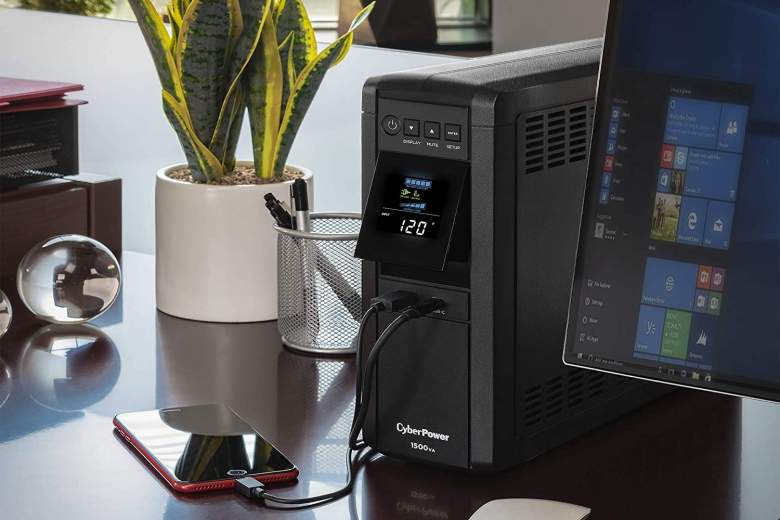
A UPS — short for an uninterruptable power supply — is a battery backup that can help your computer stay alive through both routine, intermittent power glitches and straight-up power failures. By connecting your desktop PC to a UPS, you buy yourself the time you need to save your work and shut your PC off normally rather than losing valuable data when a nearby lightning strike takes out your neighborhood’s transformer. In fact, a UPS is so critical that it’s surprising everyone doesn’t have one — they’re important not just for computers and computer equipment, but can also come in handy for electronics like a home theater receiver.
Price and complexity aren’t excuses not to own a UPS. You can get an inexpensive one for well under $100, and as a general rule, a UPS is a simple plug-and-play device. Plug it into a wall outlet and then connect your critical devices — the ones that absolutely need to stay working through a power glitch — and you’re done. Many UPS systems also come with software you can install to monitor the UPS battery status, run occasional self-tests, and see how many minutes it can run your gear given the current power load.
That doesn’t mean UPS’s are all the same, though. They vary by the power load they can support and how many outlets they include, not to mention a slew of other features. I’ve rounded up the best UPS choices across a range of price points and feature sets. Read on to see which one is best for you. Not sure you know all the UPS lingo? Read the end of the article for buying advice and an explainer on UPS devices.
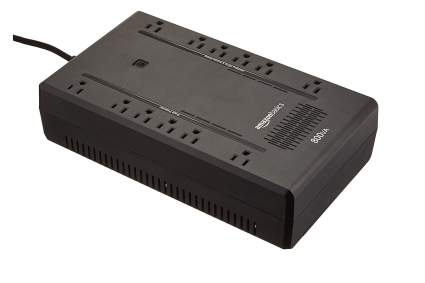
|
Amazon Customer Reviews
|
Price: $75.89 Shop at Amazon | Shop now Read our review |

|
Amazon Customer Reviews
|
Price: $194.95 Shop at Amazon | Shop now Read our review |

|
Amazon Customer Reviews
|
Price: $114.99 Shop at Amazon | Shop now Read our review |

|
Amazon Customer Reviews
|
Price: $479.70 Shop at Amazon | Shop now Read our review |

|
Amazon Customer Reviews
|
Price: $219.95 Shop at Amazon | Shop now Read our review |
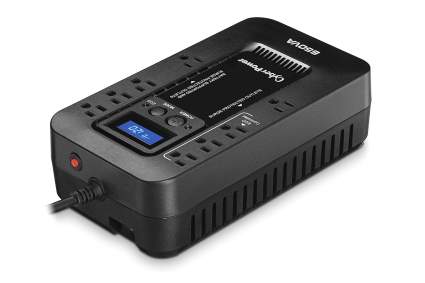
|
Amazon Customer Reviews
|
Price: $87.95 Shop at Amazon | Shop now Read our review |
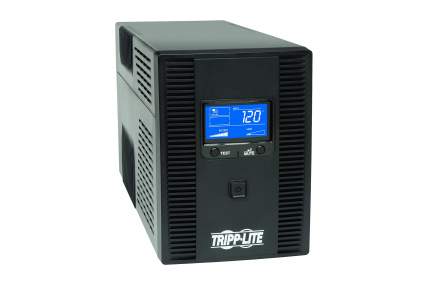
|
Amazon Customer Reviews
|
Price: $233.74 Shop at Amazon | Shop now Read our review |
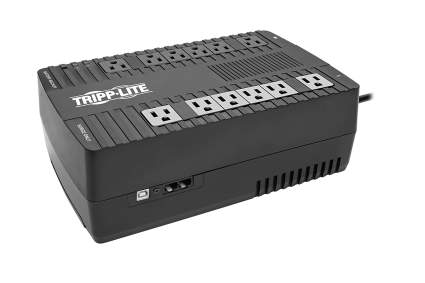
|
Amazon Customer Reviews
|
Price: $118.32 Shop at Amazon | Shop now Read our review |
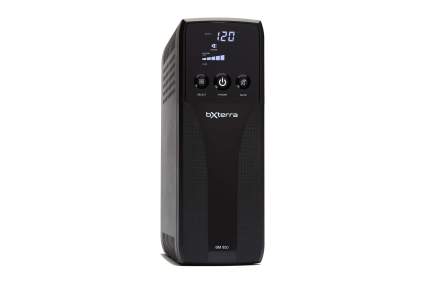
|
Amazon Customer Reviews
|
Price: $129.95 Shop at Amazon | Shop now Read our review |
-
1. AmazonBasics Standby UPS 800VA Surge Protector Battery Backup
Pros:- Plenty of outlets
- Inexpensive
- Good plug spacing
Cons:- Underpowered for PCs
- Bare-bones software
- Standby power management can be hard on connected devices
Watts: 450 | Battery power: 800VA | Waveform: Simulated Sine Wave | Outlets: 12 | Battey backup outlets: 6 | Managment software: Yes | Replaceable battery: Yes
Amazon has made a mission out of creating no-frills, budget-priced versions of all sorts of common office equipment and supplies, from USB cables computer keyboards, and offers the AmazonBasics Standby UPS to keep your computer powered through a blackout. Like most AmazonBasics products, there’s nothing super fancy here — the focus is on delivering basic functionality at a good price, so if your power management needs are modest, this can get the job done.
And when I say modest, I do mean modest — this UPS is best suited to smaller appliances. There’s not enough juice here to reliably back up most desktop computers like a typical 16GB laptop or desktop PC, but it can handle routers, gaming consoles (like an Xbox One) and other smaller electronics. The UPS comes in three sizes, from 400VA to 800VA, and the largest version is the right answer most of the time. It comes with 12 outlets, court of which are widely spaced to accommodate oversized plugs. Half of the outlets are protected by battery backup; the other half are simply surge protected.
Amazon provides a bare-bones power management app for the UPS, which doesn’t offer a lot of features, but perhaps the more important consideration is the fact that this simple UPS uses the least complicated route to switching over to battery mode: standby power management, which can be hard on your devices and may not be ideal for some very sensitive electronics.
Find more AmazonBasics Standby UPS information and reviews here.
-
2. CyberPower CP1500AVRT AVR UPS
Pros:- High capacity 900 watt battery
- Good outlet layout
- Support for GreenPower UPS Bypass
Cons:- No LCD display
- Could use more outlets
- No USB charging
Watts: 900 | Battery power: 1500VA | Waveform: Simulated Sine Wave | Outlets: 8 | Battey backup outlets: 4 | Management software: Yes | Replaceable battery: Yes
CyberPower’s CP1500AVRT AVR UPS is an imposing tower of a battery backup system. It stands at the top of the product lineup, which spans from 685VA to 1500VA. This 900-watt model is enough for even the beefiest of gaming computer systems and, at a half-load of about 450 watts, it should run for 11 minutes. If you don’t need quite this much battery, the CP1200AVR is also an excellent choice.
In back, you’ll find eight outlets; one group of four offers battery backup and the other four receive surge protection only. In the battery group, one outlet is spaced quite distant for larger plugs, but all the outlets are a little further than standard, which helps with moderately oversized plugs. The front of the case has a column of status lights, but no digital display.
Befitting a UPS of this size and capacity, the CP1500AVRT is a line interactive model with Automatic Voltage Regulation. The UPS also supports a mode called GreenPower UPS Bypass, which allows utility power to bypass the UPS transformer when AC power is stable, which reduces energy consumption, noise, and heat buildup. It’s also is compatible with CyberPower’s excellent PowerPanel Personal power management software.
Find more CyberPower CP1500AVRT AVR UPS information and reviews here.
-
3. APC UPS BE850G2
Pros:- Two USB charging ports
- Nine outlets with wide spacing
- Automatic shutdown capability
Cons:- Not a line-interactive UPS
- No digital status display
- Not all oputlets are battery backed
Watts: 450 | Battery power: 850VA | Waveform: Simulated Sine Wave | Outlets: 9 | Battey backup outlets: 6 | Management software: Yes | Replaceable battery: Yes
If you need a modestly sized UPS with modern flourishes — like USB charging ports — then the APC UPS BE850G2 is “standing by” to help. It comes in a few sizes but go straight for the 850VA version, which has a slender profile, nine outlets, and a pair of USB ports for charging devices. Three of the outlets are widely spaced for oversized plugs, and three of the outlets are surge protection only.
APC’s PowerChute power management software is among the best you can find for consumer-level APCs. it’s user-friendly and can be configured to automatically shut down your equipment gracefully during a power failure if you’re not around when that happens.
Like most APC UPS systems, this one gives you a “cold start” capability — if the power is out and your UPS has a full charge, you can actually use it to start and run your electronics temporarily from a cold start. On the other hand, like many inexpensive UPS models, this one is a standby model, rather than offering a line-interactive capability. At a half-load of 225 watts, the UPS has an estimated 11 minutes of runtime.
-
4. APC 1500VA Smart UPS with SmartConnect
Pros:- Cloud conencted
- Eight outlets
- Line interactive
Cons:- Very expensive
- Outlets are tightly spaced
- Fairly large
Watts: 1000 | Battery power: 1500VA | Waveform: Sine Wave | Outlets: 8 | Battey backup outlets: 8 | Management software: Yes | Replaceable battery: Yes
While the APC 1500VA Smart UPS is aimed at businesses, it is often purchased by home users as well thanks to its simplicity and ease of use. It comes in a variety of sizes — from 750VA to a massive 3000VA — but I am focusing in the 1500VA model, which is the sweet spot in the product line, beefy enough for virtually any home PC (even a high-powered Ryzen 9-powered desktop PC, for example) and peripheral configuration.
The UPS is fairly large and has a control panel and digital display on the front, and access to eight outlets in back. Perhaps the most useful feature: In addition to a standard power management app, APC has built in an Ethernet port and the UPS can be easily connected to the cloud, so you can check the system’s status online from anywhere. The cloud service also makes it easy to perform firmware updates and even get an estimate on when the battery is due to be replaced.
The sine wave waveform means the UPS is going to be most compatible with the broadest range of electronics, and it is line interactive with Automatic Voltage Regulation, which gives you better handling of surges and blowouts, plus better switching during full-on power failures. At a half-load of 500 watts, APC says the UPS should run for about 23 minutes.
Find more APC 1500VA Smart UPS information and reviews here.
-
5. CyberPower CP1500PFCLCD PFC UPS System
Pros:- Powerful 1000 watt UPS
- Color LCD display tilts out for easy viewing
- Two USB ports (incluing USB-C)
Cons:- Somewhat expensive
- Only two outlets for oversized plugs
- Only the 1500VA version has the tilt screen
Watts: 1000 | Battery power: 1500VA | Waveform: Sine Wave | Outlets: 12 | Battey backup outlets: 6 | Management software: Yes | Replaceable battery: Yes
If you’re looking for a high-quality and powerful UPS that checks all the important boxes, look no further than the CyberPower CP1500PFCLCD PFC UPS System. It’s a tower design UPS that, like the bXterra 1500VA BM1500AVRLCD UPS, stands out from the crowd because of its gorgeous good looks. It has a multifunction color LCD display — which is itself a rarity among UPS units — that tilts upward for easy viewing. Most UPS units live on the floor, so this is not just pretty, but highly functional, since you no longer need to crawl on the floor to see what the UPS is reporting.
This 1000-watt unit has a generous 12 outputs in back. Half are battery backup, the other half are just surge suppressed, and within each group there’s one outlet with extra room for oversized plugs. There’s more, though: In front, Cyberpower gives you easy access to a pro of USB ports for charging mobile devices — one USB-A and one USB-C port. Running with a 500 watt half load, the UPS can provide power for about 10 minutes.
For the most reliable operation, this UPS generates a true sine wave, so it can be used with sensitive electronics that don’t play well with simulated sin waves. It also features Automatic Voltage Regulation and is line-interactive for clean, instantaneous switchover during brownouts and power failures. Like other Cyberpower UPS models, this one also has GreenPower Bypass, which allows utility power to bypass the UPS transformer, when AC power is stable, which reduces energy consumption, noise, and heat buildup.
Find more CyberPower CP1500PFCLCD information and reviews here.
-
6. CyberPower EC650LCD Ecologic UPS
Pros:- Inexpensive
- Has option for Eco mode
- Digital display
Cons:- Only handles modest power loads
- Eco mode often more trouble than it's worth
- Standby unit
Watts: 390 | Battery power: 650VA | Waveform: Simulated Sine Wave | Outlets: 8 | Battey backup outlets: 4 | Management software: Yes | Replaceable battery: Yes
For offices with modest UPS needs, consider the CyberPower EC650LCD Ecologic UPS. Looking like a surge suppressor on steroids, this unit lies flat on the floor with eight outlets encircling the perimeter and — unusual in this price range — a digital display. Two outlets are widely spaced for oversized plugs, and half are protected by battery backup. That’s where things get interesting, though; the four remaining outlets are surge protected, but three of them support “Eco” mode. When using Eco mode, the UPS stops supplying power to a device that it senses has been turned off or gone to sleep. That prevents “vampire power” from continuing to cost you money when the device isn’t actually working. There’s a downside, here though, which is why you have the option to turn off Eco mode. Often, you want power to continue to flow to sleeping devices — either for charging or to enable them to turn on instantly. My opinion? This feature is generally useless.
There are several models in this CyberPower line from 450VA through 650VA (this model) and up to 850VA. They’re all budget-priced and consequently take some shortcuts — this is a standby device, for example, rather than line-interactive, so some devices might have trouble switching over during a power failure. And the lack of Automatic Voltage Regulation means the power isn’t being conditioned for your devices as effectively as with other UPSA models. But at a 50% load, this UPS should be able to keep you running for about eight minutes.
Find more CyberPower EC650LCD Ecologic UPS information and reviews here.
-
7. Tripp Lite SMART1500LCDT 1500VA 900W UPS
Pros:- 900 watts of power
- Pure sine wave for delicate equipment
- line interactive switching
Cons:- Mundane physical design
- Modest number of battery-backed outlets
- No USB charging
Watts: 900 | Battery power: 1500VA| Waveform: Sine Wave | Outlets: 10 | Battey backup outlets: 5 | Management software: Yes | Replaceable battery: Yes
The Tripp Lite Tripp Lite SMART1500LCDT is the kind of UPS that seems to roll up its sleeves and do its job without trying to draw much attention to itself; it’s not especially attractive and, compared to many other UPS models, is something of a bulky brick. This particular model is at the top of Tripp Lite’s offerings — you can step down as low as 350 watts and 700VA with other models.
The front of the UPS has a digital display; in back, you’ll find 10 outlets. Half are battery protected; the rest are just surge protected. One from each group is spaced to allow for large plugs. So while it doesn’t look like much, the UPS generates a true sine wave for sensitive and delicate electronics, and has a line-interactive design for instant switching when something goes wrong with your power. With a 450 watt half-load, you can expect the battery to provide about 10 minutes of power. Tripp Lite also provides power management software that lets you configure the UPS via a USB connection.
Find more Tripp Lite SMART1500LCDT UPS information and reviews here.
-
8. Tripp Lite 900VA UPS AVR900U
Pros:- Quite affordable
- Line interactive with AVR
- Four widely spaced outlets
Cons:- Limited to under 500 watts
- No digital display
- Bulky
Watts: 900 | Battery power: 1500VA| Waveform: Sine Wave | Outlets: 10 | Battey backup outlets: 5 | Management software: Yes | Replaceable battery: Yes
Here is one more budget-priced UPS. The Tripp Lite AVR900U strips away fancy features like digital displays, tower designs, and USB charging. What’s left are the essentials at a good price. The beefiest in the family, the AVR900U packs 900VA and 480 watts in a surge suppressor-style body. It lies flat on the floor and offers an even dozen outlets. Half are battery backup; the remaining are surge-only. But each group gives you two widely spaced outlets for oversized plugs.
Internally, this is a line-interactive UPS, which is kind of remarkable for a unit this price. It includes Automatic Voltage Regulation, which gives you cleaner current and better handling of surges and blowouts, and you get about 10 minutes of runtime at a half load (450 watts). You might not need all this wattage — right now — but with this pricing, if you are planning to get a Tripp Lite model in this family, it’s not worth saving a few dollars for a less capable UPS. You might as well get the biggest one in the family.
Find more Tripp Lite 900VA UPS AVR900U information and reviews here.
-
9. bXterra 1500VA BM1500AVRLCD UPS
Pros:- Great aesthetics
- Line interactive
- Five battery protected outlets
Cons:- Only one outlet is widely spaced
- No USB charging
- Repalcement battery is pricey
Watts: 900 | Battery power: 1500VA | Waveform: Simulated Sine Wave | Outlets: 10 | Battey backup outlets: 5 | Management software: Yes | Replaceable battery: Yes
Aesthetics may not be at the top of your list when choosing a UPS to keep your gear running, but there’s nothing wrong with one that looks as good as the rest of your gear. The bXterra 1500VA BM1500AVRLCD features a marvelous visual design that complements its features and capabilities — something that many other UPS makers pay little or no attention to. It has a vertical tower design with a sharp digital display and trio of buttons in front, with some attractive texturing to add some visual flair.
It comes in a handful of battery capacities, from 850VA ll the way up to 1500VA, and the price difference isn’t substantial from the lowest to the highest, so we’ll look at the 1500VA. It’s a line-interactive model that features intelligent Automatic Voltage Regulation to stabilize the incoming current, which treats your connected devices more gently.
Around back, it has a generous 10 outlets, half of which are battery connected (the rest are surge-only), though unfortunately only a single outlet in each group is spaced widely enough to fit oversized plugs.
The UPS also allows for automatic shut-off — always a welcome feature — and the digital display shares useful data, including remaining battery life, voltage levels, and more. At a half-load of 450 watts, bXterra estimates about 11.5 minutes of runtime.
Find more bXterra 850VA BM850AVRLCD UPS information and reviews here.
How to Shop for a UPS
You know that a UPS is essentially a big battery that intervenes when you lose power -- pretty simple in concept. But what features are important when you shop for one? What does all the lingo mean? What size UPS should you buy? Here's what you need to know.
Let's start with size -- how big the UPS should be. UPS systems are usually rated two ways: in power (measured in watts) and apparent power (in volt-amperes). For any real-world UPS shopping trip, you only need one of these numbers, and since virtually all UPS units are rated using both numbers, go with watts, which are much easier to calculate. Just make a list of all the devices you plan to plug into the UPS and add up the total wattage each one draws. That number should be the minimum size of UPS you buy. A typical computer and monitor may use 400-800 watts, for example, depending upon how large the power supply in the PC is.
Also take stock of how many power cords you have, since you'll need to plug them into the UPS. Anything that absolutely must stay on during a power failure needs to go in a battery-backed outlet, while less critical devices, like desktop computer speakers, may go into the surge-only outlets. But make sure there are enough outlets and they'll fit in the space available. In other words, are there enough slots for oversized plugs?
Complicating matters, you should be aware that UPS systems come in a number of flavors. There are three kinds of UPS systems you can buy:
Standby UPS units keep the battery in an independent circuit from the main power loop. When the UPS senses a loss of main power, the standby mechanism kicks into gear, mechanically switching your devices to the battery. This happens very quickly -- usually in less than 100 milliseconds -- which should generally be fine for most consumer electronics. But it's hard on the equipment, and some devices will konk out before the switchover is complete, potentially costing you data. Generally, you'll only find this in the least expensive UPS systems.
Line-interactive UPS units are more typical. Thanks to Automatic Voltage Regulation, this kind of UPS can smooth over brownouts and other glitches in power, essentially conditioning the line to better protect your connected equipment. It can also leverage this tech to switch over to full battery power more efficiently, which is better for sensitive and delicate electronics.
An online UPS is the most expensive kind of UPS unit, and generally only available for enterprise business users. An online UPS fully integrates the battery backup into the power loop; the connected equipment is essentially isolated from utility power and there's never even the briefest delay if a power failure means needing to switch from wall power to battery backup.
That's not all; you may also see that some UPS systems output power in the form of a pure sine wave, while others use a simulated or approximated sine wave. This might sound somewhat esoteric, and in some ways it is. Just know that some very sensitive or delicate electronics -- generally in industry, and less commonly at home -- work best when fed a pure sine wave. A simulated sine wave is one in which the power is generated in a stepped, digital approximation of a sine wave, and sensitive equipment will not tolerate that kind of signal. As a general rule, few home electronics are sensitive enough to be affected.
The Best Value in a UPS
If you are looking for a simple and inexpensive UPS, you have a few solid options. Most of the least expensive UPS units use standby power, though, which isn't ideal. The best option: Tripp Lite's excellent 900VA UPS AVR900U. This no-frills UPS has a wealth of outlets and is line-interactive, with Active Voltage Regulation. Few other UPS units in this price range can come close.
If you need a beefier UPS with more features, though, the field widens. Tipp Lite again comes to the rescue, this time with the SMART1500LCDT UPS, a superb model that has lots of power, a smooth sine wave function, and line-interactive switching. The only downside? Honestly, you might long for a UPS that looks as pretty as the rest of your home office or computer. And if that's the case, then the CyberPower CP1500PFCLCD is in the same price range. It's line interactive with AVR, so it will treat your devices well, but also has that sweet tilting color LCD display.